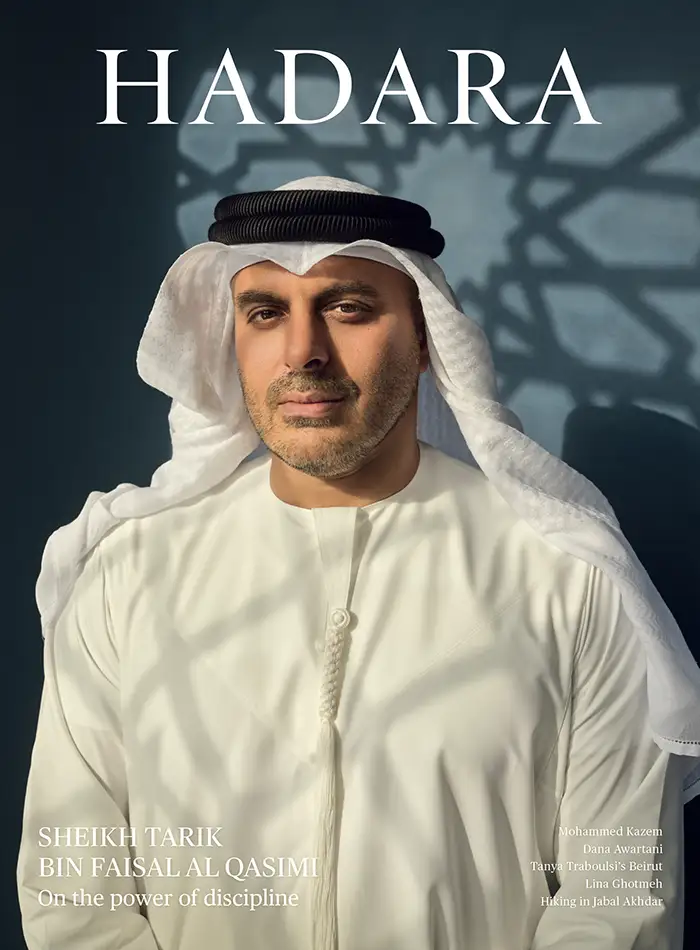Artist of the People
Hassan Hajjaj’s ability to reflect the world around him has kept him relevant as an artist for more than three decades.
By Anna Seaman
Lunging, jumping, and vaulting, dance masters demonstrate capoeira, inviting onlookers in Sharjah’s Arts Square to join them. Few will have guessed that the 60-something man in loose white trousers and a light pink T-shirt, part of the crowd, was the artist Hassan Hajjaj. He organised the workshop as part of Sharjah Biennial 15 in February as a way to engage the public with his documentary Gnawa Capoeira Brothahood (2023). A deeply personal project that took two decades to come to fruition, it traces the historical similarities between Gnawa, a Moroccan performance art rooted in Sufi music, and the Afro-Brazilian martial art of capoeira.
As members of the public joined the dancers and musicians, what played out was part workshop that paid no mind to experience or skill, part professional performance. Most of all, it was a laid-back celebration of humanity. Hajjaj was never the centre of attention, and that is exactly how he likes it. “I don’t want it to be about me. I want it to be about the people,” he says from Marrakech, where he now spends most of his time.
Although his family moved to London when he was 13, Hajjaj never left his Moroccan roots behind. As his career gained traction through the mid-1990s and the turn of the millennium, the two cultures fused to form his artistic language. His work, which explores identity, is rooted in this duality.
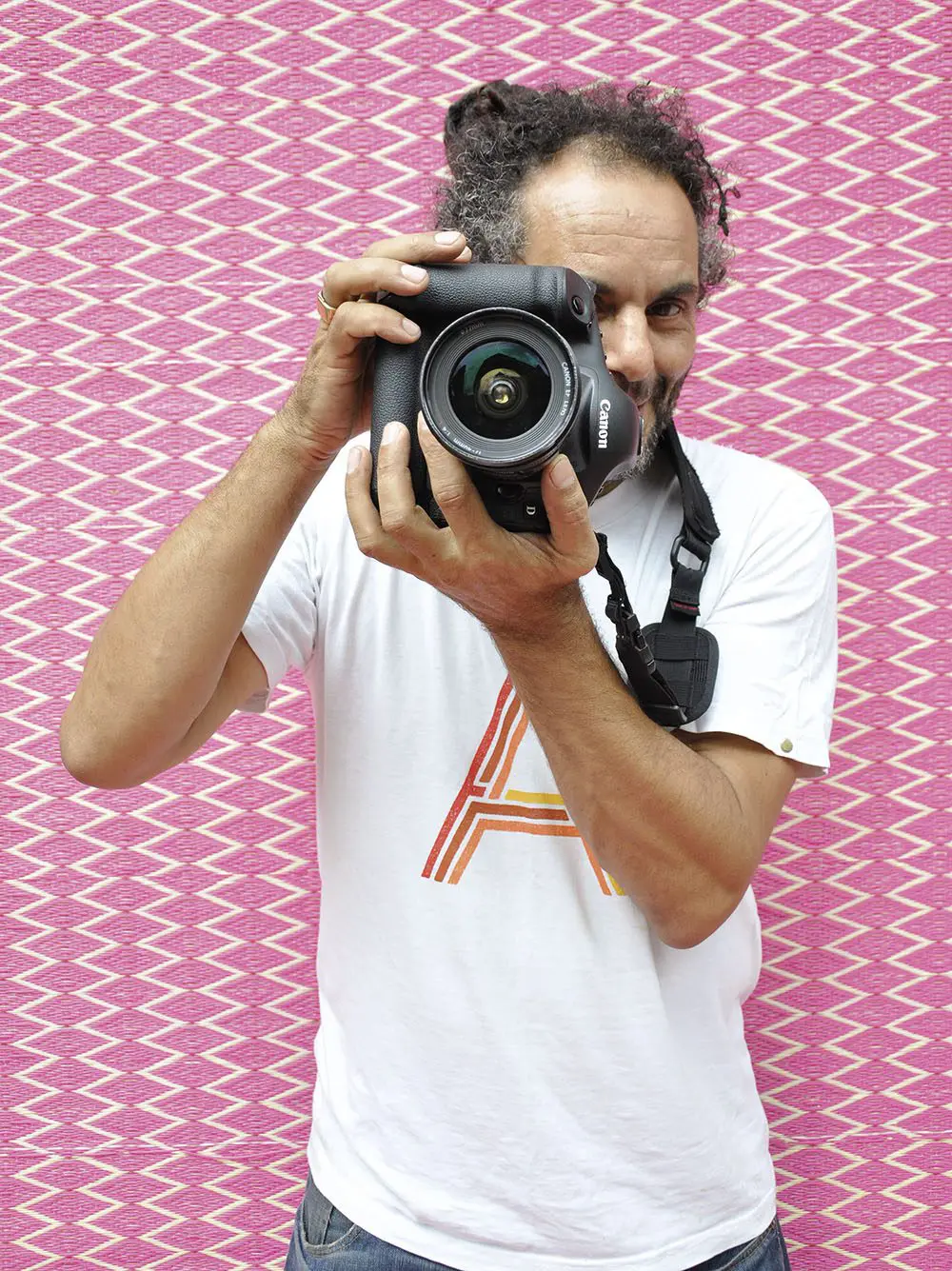
Top image, KESH ANGELS (2010) Part of the Kesh Angels series. Courtesy of Karima & crew and the artist. Portrait of Hassan Hajjaj by Jenny Fremont.
He first bought a camera in 1989, at the age of 28. He didn’t set out to become an artist; he would take pictures of friends, fellow creatives in London’s music, art, and fashion scene, to explore a growing passion for the craft. It was following a trip to Morocco in 1993 that he began to challenge the stereotypes about the country of his birth, to document its cultural diversity, at once traditional and contemporary, to present it as something more than an exotic backdrop. His entry into the art world, he says, started here.
As a photographer, his fascination with people, body language, fashion, music, street culture, and art fuel him to create stylised, maximalist portraits. In his seminal photo series Kesh Angels, a hijab-wearing gang of women from Marrakech—henna artists who ply their trade in the city’s tourist industry—strike Marlon-Brando-esque poses atop motorbikes. Traditional clothing, often the subjects’ own, is augmented with heart-shaped sunglasses and bold brand logos. Hajjaj sought to provoke with this blend of the foreign and the familiar. The backdrop and the angle of the shots lend a cinematic feel.
As his profile rose, amid a post-9/11 world that was verging on obsession with Arab cultures, Hajjaj took his work to the level of installations. Although the output was typically a single photograph, he would make a detailed sketch of the scene that he had in mind and would often design the furniture and other accessories from everyday objects—tables made from upturned Coca-Cola crates or lamps fashioned from old paint cans. His art is more than imagery; it is an accessible, amusing subculture. It also raises commentary on a consumerist world.
“If someone had told me three years ago that I would have my own tea brand, I would have laughed, but it allowed me to put all my ideas into one pot: art, design, music, photography.”

ALO WALA (2015) Part of the My Rockstars series. Courtesy of Alo Wala and the artist.
From the beginning, his photographs have straddled the divide between real life and performance art. They echo too the tradition of African photo portraiture. For his ongoing My Rockstars series, which pays tribute to individuals who are not always famous but have inspired the artist, he shot friends and influential figures—among them British painter Lynette Yiadom-Boakye and club musician Alo Wala—in his trademark style wearing exaggerated costumes and adopting staged poses.
An appropriation of pop culture—he frames his images with everyday objects: canned tomatoes and olives, squeezy ketchup bottles, Legos with Arabic lettering—brought comparisons with Andy Warhol. (The repetition and geometry also echo Islamic art.) He has “no problem” with the link, but questions “why I needed to be compared to a Western artist for validation.” He later embraced it, however, launching his own clothing brand, Andy Wahloo—a play on the Moroccan slang “wahloo”, meaning “I have nothing”.

RILENE (2013) Part of the My Rockstars series. Courtesy of Rilene Martin and the Artist.
Clothing is a big part of his practice, taking a central role in his photography. The outfits are often custom-made, sourced at markets, featuring the bold colours of Morocco and international brands. His interest in fashion predates photography: he opened a shop selling streetwear in London in 1984 and still has an outlet there today—Larache Shop, in Shoreditch. One of his most sought-after items is the red babouche—or Moroccan slipper—emblazoned with the Louis Vuitton logo.
Hajjaj’s star keeps rising. This year, he had a solo show at Savannah College of Art and Design in Georgia, USA, that featured two series, My Rockstars and VOGUE, The Arab Issue; and an exhibition at the Gitex Africa tech show; he has a group show at the Brooklyn Museum; an exhibition in London’s Tate Modern that focuses on contemporary African photography; and he has been selected as the “In Focus Photographer” for The National Portrait Gallery in London, where his work will be exhibited alongside that of the shortlist for the Taylor Wessing Photo Portrait Prize. Next year, solo shows are slated in Paris, Casablanca, Jeddah and AlUla, Saudi Arabia.

LYNETTE YIADOM-BOAKYE (2017) Part of the My Rockstars series. Courtesy of Lynette Yiadom-Boakye and the Artist.
Bewilderment is not an uncommon response to her pieces. Yet the confusion does not often stem from the too-muchness and colour saturation of her kaleidoscopic images, but rather from the viewer’s inattentiveness to the world around them. “I happened upon a tour of schoolboys at my last show in the Emirates and heard one of them say, ‘Why soap?!’ It was such a funny thing. They were really into parts of the show but then said, ‘We see that every day!’” Her excitement is audible as she recalls this moment which, in a way, validates her practice. “You see it every day, but how often do you think about what it really is?”
Like the perfume and food which are also her frequent subjects, soap has an intimate relationship with the body. Although she often hides people’s faces, stemming in part from the value Emirati women place on privacy, photographing these objects is still revealing. “Objects are often my answer to how you photograph things that cannot be seen,” she says. “When I photograph soap, I’m trying to photograph something that touches a body. When I photograph food, I’m trying to photograph care. For me, care looks like watermelon that is perfectly sliced or a rose made of tomato skin.”
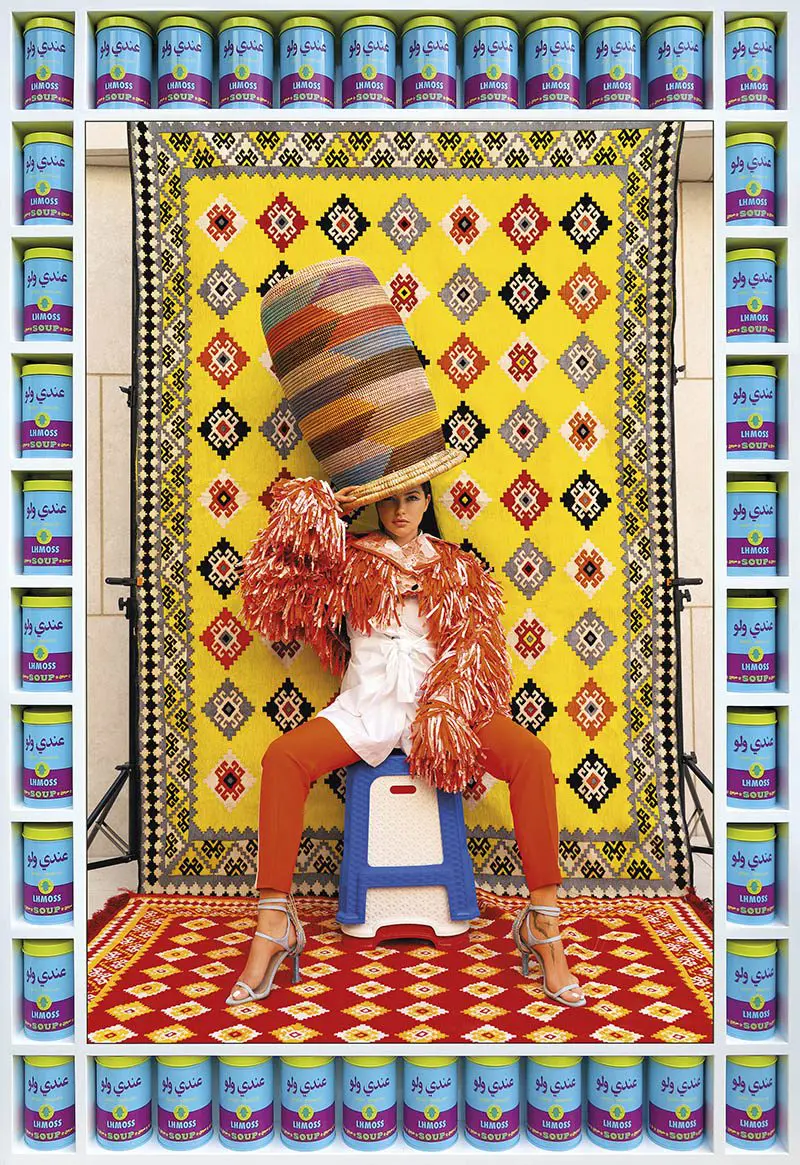
ADRIANA VOGUE (2021) Part of the My Rockstars series. Courtesy of Adriana Lima, Vogue Arabia and the artist.
During the pandemic, Hajjaj collaborated with tea maker Amine El Baroudi, originally proposing to design tea cans, which he often uses to frame his images. But it evolved into a full-blown tea brand, Jajjah. He uses the work of up-and-coming Moroccan photographers on the packaging, and on a related app uploaded the work of local musicians to offer a soundtrack for tea drinkers. “If someone had told me three years ago that I would have my own tea brand, I would have laughed, but it allowed me to put all my ideas into one pot: art, design, music, photography,” he says. “It was a new creative avenue and a challenge, but it happened very naturally.”
The collaboration was so successful that El Baroudi offered Hajjaj a space in Sidi Ghanem, the industrial fringe of Marrakech where creatives have been opening boutiques and galleries, to expand the concept. Now Jajjah is a restaurant, gallery, live-music venue and culture hub. Visitors can buy the works of local artists and photographers (currently there
is an exhibition by Idries Karnachi, an architect, designer and collage artist). It has offered a stage to rising Moroccan rappers and hip-hop artists, too. But more than that, it has showcased two principles important to Hajjaj: collaboration among creatives, and the need for established names to use their platform to support emerging talent.
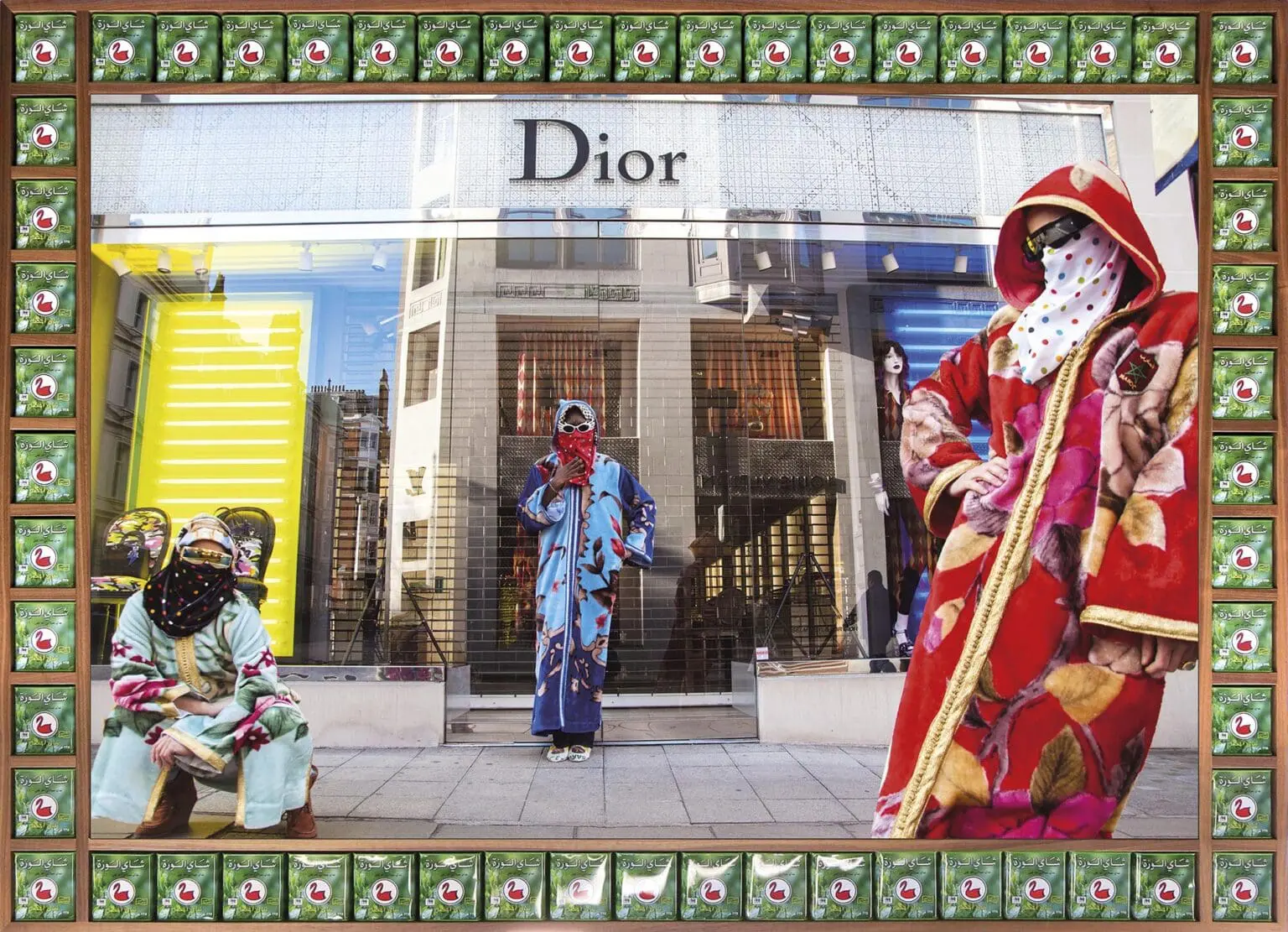
DIOR (2012) Part of the VOGUE, THE ARAB ISSUE series. Courtesy of the artist.
“Jajjah has given me an opportunity to bring through others that I am a fan of and to give advice if needed. It has been great to be able to do that because when I started, I came in through the back door. I remember being a fan of artists like Shirin Neshat and Youssef Nabil, and then one day, I was next to them in group shows. I’ve always wanted to help others whose work I admire, and it is great to see some of those talents shining now.”
Naturally is a word Hajjaj uses again and again, describing how things occur organically or how relationships come together. Earlier this year, he photographed Alicia Keys and Swizz Beatz in AlUla. “I would have shot them even if they weren’t famous,” he says, noting their shared love for music and art. He had met Swizz Beatz at one of his exhibitions and they had stayed in touch, finally crossing paths in Saudi Arabia and making time to shoot the portrait.
Hajjaj surrenders to the ebb and flow of life. “I consider it part of my practice to stay true to myself,” he says. “I take in what is around me and what has influenced me and don’t want to be too intellectual, too smart, or go outside of myself. I love people and I’m fascinated by what makes them tick. I love and appreciate all cultures, and I consider myself very lucky to still be relevant after 30 years, that people still like my work and come to my shows. I never take that for granted.”
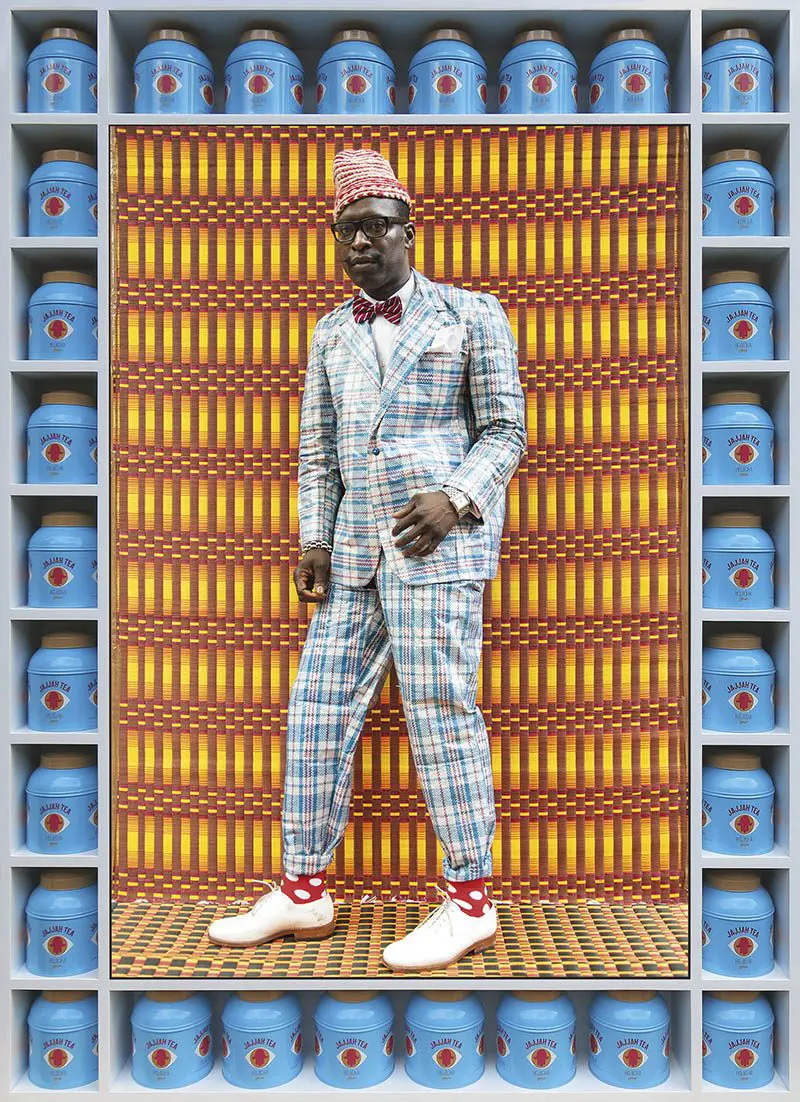
ALEXANDER NILERE (2012) Part of the My Rockstars series. Courtesy of Alexander Nilere and the Artist.




